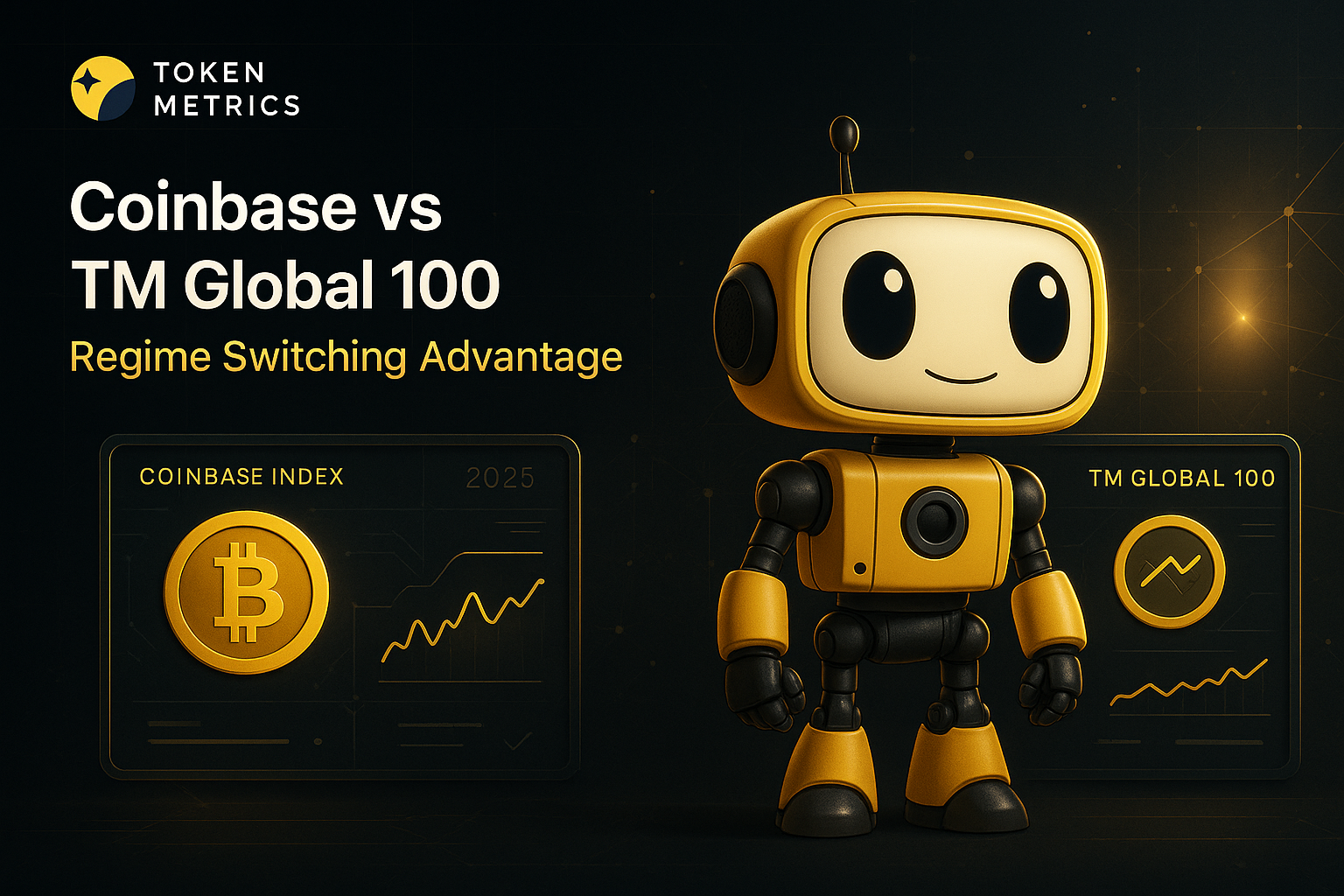The crypto market in 2025 is defined by a new wave of innovative investment tools, making the choice of the right crypto index more crucial than ever. Amid the landscape, the comparison of Coinbase Index vs Token Metrics Global 100 stands out; each reflects fundamentally distinct philosophies about crypto investing. While Coinbase’s COIN50 Index leans on a traditional buy-and-hold strategy reminiscent of the S&P 500, the Token Metrics Global 100 introduces a regime-aware system that reacts to market conditions. This exploration dives into how these indices differ, where they overlap, and why regime switching could reshape the future of crypto investment frameworks.
Introduction to the Crypto Market
The cryptocurrency market has undergone rapid transformation, granting participants access to a diverse portfolio of altcoins and a multitude of fiat currencies supported by major exchanges. Gemini and Coinbase both serve prominent roles in this changing environment, supporting retail and institutional users alike. Gemini, established by Cameron Winklevoss, is lauded for its rigorous security—implementing offline cold storage to protect assets. Meanwhile, Coinbase, founded by Brian Armstrong and Fred Ehrsam, boasts a robust regulatory approach aimed at establishing user trust through compliance and strong protections.
Both platforms facilitate the use of top fiat currencies like USD and EUR, streamlining deposits, withdrawals, and trading for a broad user base. Their mobile apps empower users with mobility for portfolio management and trading. In trading volume, Coinbase leads with significant market participation, while Gemini’s volume has been on the rise, expanding with the broader market growth.
While both exchanges offer a wide array of supported cryptocurrencies and user-friendly services, differences remain. Gemini emphasizes maximum security and insured funds, favored by risk-averse or institutionally minded users. Coinbase appeals strongly to newcomers through interface simplicity, education, and a competitive fee model (albeit with more complex fee structures than Gemini’s straightforward approach). Specialized offerings—like staking rewards at Coinbase, or Gemini’s Earn—cater to different investor interests and strategies, including institutional demands.
Ultimately, the decision between platforms is shaped by individual user needs. Both platforms allow fund transfers between accounts, support in-depth pricing tools, and offer features intended to help users make informed choices. Understanding these foundational aspects sets the stage for effective participation in the crypto market.
Key Comparison of Gemini and Coinbase
Both Gemini and Coinbase earn their reputations from secure, user-focused exchanges with strong regulatory compliance. Nevertheless, their operational nuances, fee structures, and specialized product offerings underscore differences that matter to crypto market participants.
Gemini’s standout security, including a cold storage-first architecture and strict regulatory oversight (notably from NYSDFS), ensures assets are well protected and managed under industry-leading standards. Coinbase, while matching these security efforts, also benefits U.S. customers via insured fiat funds and a wide-ranging regulatory focus, increasing user confidence.
Fees are a key differentiator: Gemini offers clarity with a flat rate tier system, while Coinbase has a variable, sometimes complex fee schedule. These factors can influence total trading costs, making fee structure examination an important research point for users wanting cost transparency.
Currency and asset diversity also separates the two—Coinbase often supports a greater range of fiat currencies and altcoins. In terms of trading volume, Coinbase sits at the top globally, while Gemini’s upward trajectory signals continued growth and institutional interest. Both offer institutional and bulk trading solutions, with Coinbase’s staking rewards and Gemini’s Earn providing income generation features for assets held on-platform.
User experience rounds out the comparison; seamless mobile apps, easy onboarding, and helpful interfaces are core to both platforms, with Gemini praised for beginner-friendly design and Coinbase for supporting both new and advanced investors. Ultimately, Gemini and Coinbase offer robust, but distinct, experiences—a matter of aligning platform strengths with user priorities.
The Traditional Approach: Coinbase 50 Index
Debuting in November 2024, the Coinbase 50 Index (COIN50) introduced new options for mainstream crypto market tracking. In collaboration with MarketVector Indexes, this index targets the top 50 digital assets available on Coinbase, representing around 80% of total crypto market capitalization. Its methodology is deliberately straightforward: a market-cap weighted approach, refreshed every quarter to reflect shifting capitalizations.
Presently, COIN50 is highly concentrated—Bitcoin anchors the index at 50% (maximum permitted), followed by Ethereum, Solana, and other leading assets. This mirrors the top-heavy nature of crypto markets. The approach is simple: buy, hold, rebalance—mirroring passive equity index philosophies that focus on capturing long-term growth despite short-term volatility.
Coinbase’s user-centric ethos is reflected in this index—easy entry for new investors, integrated staking rewards, insured fiat holdings, and a regulated framework. Similar to Gemini’s protective mindset, Coinbase manages asset security with cold storage and progressive regulatory practices, making COIN50 an accessible avenue for those seeking broad crypto exposure via an established platform.
The Intelligence Gap
While COIN50 reliably tracks the market, it shares a critical limitation with traditional stock indices: remaining fully invested regardless of market direction. In stock markets, this risk can often be managed because drawdowns are typically less severe. Crypto markets, however, frequently experience far deeper corrections—drawdowns in excess of 70% occurred during the 2022 crypto winter. In such environments, a fully invested index is vulnerable to significant capital erosion.
This is less a flaw and more a design trade-off inherent to passive strategies. As cycles accelerate in 2025 and volatility persists, crypto market participants are increasingly asking whether a more adaptive approach could offer better outcomes in terms of drawdown mitigation while maintaining growth potential.
Enter Token Metrics Global 100: Regime-Aware Indexing
Token Metrics, a distinguished crypto analytics and trading platform, has forged its reputation through data-driven, transparent methods. Its flagship Global 100 Index blends broad asset coverage with active risk management by employing market regime signals—adjusting asset exposure proactively to changing market environments.
What Makes TM Global 100 Different
- Broader Market Representation: Spanning the top 100 cryptocurrencies by market capitalization, TM Global 100 captures more of the crypto market, especially during bullish cycles where emerging coins outperform.
- Weekly Rebalancing: The index rebalances every week, aligning closely with shifting market landscapes—unlike COIN50’s quarterly cadence—ensuring exposures reflect up-to-date asset trends.
- Regime Switching: At the heart of TM Global 100 is a proprietary market signal that dynamically determines full market participation or a move to stablecoins, based on prevailing risk conditions.
This unique structure allows TM Global 100 to fluidly adapt between market upswings and protective stances, unlike static passive indices.
How Regime Switching Works
- Bullish Market: The index holds a diversified basket of the top 100 cryptocurrencies, capturing upward momentum across the sector.
- Bearish Market: The system rotates allocations entirely into stablecoins, emphasizing capital preservation and sidestepping major market downturns until conditions improve.
This methodology is about large-scale, structural market awareness—protecting capital during drawdowns, not chasing every small price swing.
The Power of Protection: Stringent Security Measures
Consider two hypothetical $100,000 portfolios entering a bear phase:
- COIN50 (Conventional): Remains fully invested, possibly experiencing a 60% drawdown—reducing to $40,000 and requiring a substantial recovery to break even.
- TM Global 100 (Regime-Aware): Rotates into stablecoins on bearish signals, potentially preserving the original $100,000 for redeployment when conditions turn favorable.
Reducing the impact of large losses is a powerful force—compounding advantages accrue on both risk and return, leading to a smoother overall outcome, especially in a volatile asset class like crypto.
Token Metrics: Built on Data Excellence and Commitment to Regulatory Compliance
- Institutional Research: Deep analytical coverage of thousands of crypto assets.
- AI & Quantitative Insights: Advanced models synthesize vast datasets for pattern and trend recognition.
- Proven Market Navigation: Years of outcomes across multiple crypto cycles.
- Transparent Methodology: Clear, open documentation and live holdings visibility.
All operations and rebalancing are logged and displayed in real time, reinforcing Token Metrics' commitment to transparency and regulatory-minded practices. This infrastructure allows users to fully understand and monitor index movements and risk controls.
Operational Excellence
- Streamlined Access: Enable purchases via self-custodial smart wallet in minutes.
- Portfolio Visibility: Full strategy insights, live holdings data, and transaction records.
- Transparent Fees: All transaction costs and slippage disclosed pre-confirmation.
- Real-Time Tracking: “My Indices” dashboard for performance tracking and detailed history.
COIN50, conversely, is available mainly through perpetual futures contracts on Coinbase International Exchange (not accessible to U.S. retail users), necessitating derivatives trading know-how and diminishing its general accessibility for spot investors.
Whether to choose the Coinbase Index or Token Metrics Global 100 depends on your investment approach, risk tolerance, and any liquidity limitations. Consider:
- Choose COIN50 if:
- You want straightforward exposure to the 50 most liquid crypto assets.
- A buy-and-hold, quarterly rebalanced strategy aligns with your investment philosophy.
- You have access to international futures markets and are comfortable with inherent volatility.
- Liquidity constraints are minimal, and you value market simplicity.
- Choose TM Global 100 if:
- You are seeking drawdown protection during adverse market periods.
- You value weekly rebalancing and agile portfolio management.
- Broader asset exposure, particularly to emerging altcoins, is crucial to you.
- You prefer spot over derivatives, or have access limitations to the latter.
- Risk management and adaptive exposure are part of your strategy.
- Liquidity features are important, particularly when dealing with less-traded digital assets.
The Future of Crypto Indexing and Trading Volume
The emergence of regime-aware indices like Token Metrics Global 100 reflects the maturing of crypto investment tools and approaches. Market participants increasingly expect dynamic solutions that account for crypto’s inherent volatility and cyclical risks, moving beyond static, one-size-fits-all methodologies borrowed from traditional finance. While passive equity indexing made sense in relatively stable environments, the realities of digital asset cycles often demand greater adaptability. Token Metrics Global 100’s structure—engaging markets when signals are positive and standing aside in downturns—represents this next step in the evolution of crypto index investing.
Ready to Experience the Difference?
For participants looking for broad crypto exposure with carefully managed downside risk, regime switching is no longer a luxury but an essential feature. TM Global 100 combines this with weekly rebalancing, transparent methodologies, and the analytical strength of Token Metrics, offering a compelling new solution for the modern crypto environment. As adaptive tools become standard, the future of crypto indexing looks smarter, more adaptive, and better aligned with real market behavior.
Those interested in experiencing a more responsive, risk-aware indexing approach can join the waitlist for access to future-ready crypto index solutions.
Summary and Conclusion
Both Coinbase Index and Token Metrics Global 100 play pivotal roles in the evolving crypto investment landscape, shaping the choices available to different user types. Security remains paramount across platforms—Gemini and Coinbase emphasize rigorous protections and offer advanced features, from staking and interest rewards to sophisticated interface options. Fee structures, trading volume, asset support, and operational details differ, providing a spectrum of options for market participants. In the bigger picture, the Coinbase Index vs Token Metrics Global 100 comparison encapsulates crypto’s shift from passive, static strategies to data-enhanced, flexible methodologies that recognize and navigate the unique cycles of this global marketplace.
Discover Crypto Gems with Token Metrics AI
Token Metrics uses AI-powered analysis to help you uncover profitable opportunities in the crypto market. Get Started For Free
Frequently Asked Questions
What is the main difference between Coinbase 50 and TM Global 100?
The COIN50 is a market-cap-weighted index of the top 50 cryptocurrencies, with quarterly rebalancing and a passive buy-and-hold approach. TM Global 100 expands coverage to 100 assets, rebalances weekly, and uses regime switching to adjust exposure based on market signals, offering more active risk management.
How does regime switching improve crypto index performance?
Regime switching enables the index to shift out of risk assets and into stablecoins during bearish market conditions, potentially limiting large drawdowns. This approach aims to provide smoother performance across cycles rather than maximization in any single period.
Can I access TM Global 100 if I’m in the US?
The TM Global 100 is structured as a spot index, increasing accessibility for U.S. residents. In contrast, COIN50 is available primarily through derivative products outside of the U.S., requiring access to specific international exchanges and experience with futures contracts.
Are Gemini and Coinbase safe for crypto investors?
Both Gemini and Coinbase implement strong security measures, including offline cold storage, regulatory oversight (such as Gemini’s NYSDFS license), and insurance on fiat funds for U.S. users. They continuously update protocols to align with emerging best practices in digital asset security.
Why choose an AI-powered platform like Token Metrics?
AI-powered platforms such as Token Metrics leverage machine learning and data-driven analytics to provide in-depth asset research, pattern recognition, and risk signals—helping users make more informed, evidence-based decisions in a rapidly evolving market.
Disclaimer
This article is for informational and educational purposes only. It does not constitute investment advice, endorsement, or recommendation of any financial product or strategy. Always conduct your own research and consult a qualified professional before making any investment or trading decisions. Cryptocurrency markets are volatile and involve significant risk; past performance is not indicative of future results.



.svg)


.png)




%201.svg)
%201.svg)


%201.svg)









.svg)




.png)